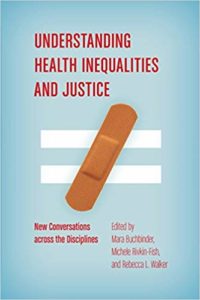Reviewed Book
Understanding Health Inequalities and Justice: New Conversations across the Disciplines. Mara Buchbinder, Michelle Rivkin-Fish, and Rebecca Walker, eds. Chapel Hill: University of North Carolina Press, 2016, 350 pp.

Understanding Health Inequalities and Justice: New Conversations across the Disciplines interrogates the theoretical and methodological assumptions behind common approaches to and policies surrounding health inequalities in the United States today. The editors—two anthropologists and one philosopher, all bioethicists—open with a series of heady introduction questions: What is justice? Inequality? Inequity? How should health-promoting resources and health care be distributed, to whom, by what criteria, and for which objectives? The next 11 chapters analytical perspectives from anthropology, bioethics, epidemiology, health policy, history and philosophy of medicine, law, medicine, nursing, philosophy, public health, and sociology.
Understanding Health Inequalities and Justice is a jewel in the interdisciplinary edited volume genre. Largely, this is due to the exceedingly careful editing by Mara Buchbinder, Michelle Rivkin-Fish, and Rebecca Walker. There is no slippage from the book’s overarching goal in any chapter. “It is our hope,” the editors write, “that empirical researchers might find their work enriched by normative debates regarding what constitutes justice, what justice requires, and where (on whom) various moral obligations lie” (p. 25). The introductory chapter discusses several theoretical frames for interdisciplinary discussion on health inequalities.
Broadly, these frames include justice theories, virtue ethics, distributive mechanisms, equality and equity, human rights, well-being, and welfare. Each subsequent chapter is organized identically: abstract, introduction, identification of a connection to specific conceptual approaches or terms in other chapters, exposition, and a discussion or conclusion that illustrates the connection to other chapters. The introductory chapter and the constancy of chapter structure are lynchpins for the book’s wide-ranging topics, which range from epidemiological and philosophical critiques of how inequalities are measured; to policy analyses (linguistic, constructivist, public health) of the Affordable Care Act and Healthy People 2010 and 2020; to case studies critiquing the liberal autonomous subject and the notion of patient-centered care; to constructions of risk in pregnancy care; to a grounded ethnographic analysis of oral health.
The three sections of the book are grouped by their orientation to understanding health inequality. Part I critically examines theoretical and pretheoretical assumptions about measurements and interventions related to health inequalities. For example, Eva Feder Kittay considers how normative assumptions of autonomy used with the intent to provide patient-centered care in American biomedical practice inadvertently reinforce health inequalities. Part II anchors Part I’s critiques in grounded, diverse experiences of health inequalities. Much like the book’s project itself, Paul Brodwin’s chapter in Part II tests the proposition that “experience-far and experience-near genres of ethical expression” of respect and recognition are sufficiently commensurate to start a dialogue to improve care, in this case psychiatric care, for the most vulnerable (p. 185).
Part III deconstructs and traces the cultural production of policy and policy implementation relative to health inequalities. In her chapter in Part III, Carolyn Moxley Rouse examines how and why Healthy People 2010 largely failed in its goal to reduce racial and ethnic health disparities due to incomplete, selective incorporation of data during its construction. Rouse draws on years of ethnographic work with African American children with chronic illness or disability, their families, and their clinicians to throw into relief-embedded assumptions about cultural homogeneity among racial minorities and biomedical practitioners in Healthy People 2010. Overall, Understanding Health Inequalities and Justice ties into ongoing and emerging discussions in medical anthropology on measurement, surveillance, and risk; health care reform, particularly the Affordable Care Act; knowledge production in biomedicine and health policy; and research ethics and medical subject-making.
Rather than discussing weaknesses, I would offer a suggestion to the reader: Unless you have significant training in bioethics or philosophy, spend the time necessary to digest the concepts in the Introduction. There, the editors clearly define key terms essential to the text: justice, inequality, inequity, and human rights. The authors take the time to do so for good reason. Just as anthropologists are suspicious when other disciplines co-opt ethnography without grounding in the requisite canon, so, too, should we be careful when employing concepts that have emerged from hundreds of years of conversation about the nature and value of justice, virtue, and egalitarianism. Deeply complex, each term in the introductory chapter is prone to misuse or application if poorly understood, as they often are in public discourse or in academic discussions outside of philosophy and bioethics. It would be difficult for a bioethics novice to fully absorb the terms in the Introduction without reference to other works in virtue ethics, egalitarianism, and justice. The authors neatly lay out the concepts and theories, but especially for students, the introductory chapter will likely require time to absorb, additional reference resources, and in-depth discussion.
What philosophy, anthropology, and the dozen or so other disciplines represented in the text share is their commitment to fine-grained analyses of what health inequality means in the United States today. The book not only intends to speak directly across disciplines—it actually does so. It will be of interest to any medical anthropologist who works in health justice and equality, human rights, critical studies of big data, and research ethics, as well as the many medical anthropologists who have cross-appointments in schools of medicine, public health, nursing, and related areas. I envision the book in graduate seminars in any discipline represented in the authors’ bios, but especially in bioethics, medical anthropology, medical humanities, public health, and health policy. It could be an anchor text for a capstone research or service-learning undergraduate course in each of these disciplines or medical school research practicum. Given the enduring nature of health inequalities and increasing efforts to work across disciplines to ameliorate them, Understanding Health Inequalities and Justice could be used creatively as a guide for interdisciplinary curricular, program, or research core building around health equity.